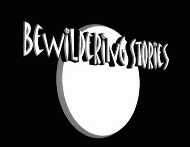Challenge 124
Please read “The Sum of Our Lives” and “Into the Burbs” first.
Active Connections, Passive Voice
- In the first four paragraphs of Sean Hower’s “Into to the Burbs,” cite at least two details that foreshadow a journey into Hell.
- “Into the Burbs” and Jörn Grote’s “The Sum of Our Lives” both take place at night, but other than that, the two stories are almost diametrically opposed. Can you list the ways?
- In what ways does “The Sum of Our Lives” resemble Omar Vega’s “A Distant Island,” which concluded in issue 118? In what ways is it different?
- Some stories have a “passive hero,” namely a main character who does not shape events so much as serve as their object. That may be good, bad, or anything in between:
- In Robert A. Heinlein’s novel, Citizen of the Galaxy, the passive hero is, in my estimation, devoid of reader interest, although some people seem to think the novel is one of the best they’ve ever read. There’s no accounting for taste.
- On the other hand, the paragon of the passive hero is Voltaire’s Candide, who is battered from pillar to post all around the world. But cultivating one’s garden despite misfortune and human perversity is precisely the point of the novel.
At this point, would you say that any of the following are passive heroes?
- Palance Demondread, in Julian Lawler’s Battle Seer ?
- Toni, in Michael E. Lloyd’s Observation One ?
- Janet, in Gillian Marshall’s “Rain Man” (issue 121) ?
- The 16-legged being in Byron Bailey’s “Necklace” (issue 120) ?
- Judith, in Dustin LaValley’s “Of Judith and the Night” (issue 120) ?
- Can you name any others?
How might a passive hero be changed into an active one? How would that change the story?
Copyright © 2004 by Bewildering Stories
What is a Bewildering Stories Challenge?

